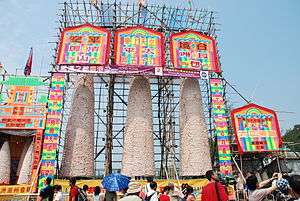Ping on bun
Ping on bun (Chinese: 平安包; Jyutping: ping4 on1 baau1; pinyin: píngānbāo) is a type of traditional Hong Kong food.
History

In mid-Qing Dynasty, a pandemic had spread through villagers in Cheung Chau and caused a lot of deaths. As a result, villagers decided to gather before Pak Tai and pray, and later on were instructed to set up altars and say mass to scare the evil spirits away. Afterwards, islanders built temples to show gratitude to Pak Tai’s blessings, and see him as the guardian of the village.
As years went by, the annual Cheung Chau Bun Festival became a tradition. Villagers dressed up as gods to vanquish the evil and Ping On Bun is used to build the bun towers (three towers that stood 18 meters tall and made of a huge number of buns) during the Cheung Chau Bun Festival. Buns were to be distributed to the villagers after prayers and used to offer sacrifice to Gods and ghosts.[1]
The villagers believed that eating hot Ping On Bun helps warding off disease, and spread the Pin On Buns which have been powdered into the sea can help to restore calm of the sea.[2]
Ingredients
Ping On Bun originated from Hong Kong. Its major ingredients include low-protein flour, lotus seed paste as well as sugar. It is best served at hot or room temperature. There are also some special flavours such as red and green bean.
Recipe
- low-protein flour 200g
- sugar ¼ teaspoon and 2 tablespoon
- lotus seed paste 45g
- Lye Water 3-4 drops
- yeast ½ teaspoon
- water 100g
- baking powder ⅓ teaspoon
Steps
- Add the yeast and ¼ teaspoon of sugar to the water
- Wait for 5 minutes
- Add low-protein flour to the mixture
- Knead the dough for a few minutes
- Spray the pan with oil before putting the dough in it
- Cover the pan and wait for it to rise
- Mix the 2 tablespoons of sugar with the baking powder
- Add the lye water into some pure water
- Mix it well and add the dough in to the mixture
- Mix the dough and knead it for few minutes
- Divide the dough into four equal parts
- Take one part of the dough
- Put the lotus seed paste or red beans inside as stuffing
- Shape the dough into a sphere shape
- Put it into the steamer for 30 minutes
- Increase the temperature and cook for 10 minutes
- Stamp “Ping On” on the bread
Cultural Influence
More than 48,000 tourists go to Cheung Chau during the Cheung Chau Bun Festival.
The distribution of Ping On Buns outside the Pak Tai Temple attract a hundred people queuing up since 8 o’clock in the morning.[3] Guo Jin Kee, a shop selling Ping On Bun, sold more than 10,000 Ping On Buns a day while there were long queues outside the shop in the morning.[4] Tourists have to wait for half an hour to buy fresh Ping On Buns.
Kwong Koon Wan, who earned more than ten thousand dollars through selling a variety of Ping On Bun souvenirs, said the Ping On Bun cushions and fans were popular among the tourists and expected that he could earn more than thirty thousand dollars.[5]
Social Issue
Food Safety
On 24 May 2015, Yi Ma Bakery located in Sun Hing Street in Cheung Chau was found to sell Ping On Buns that contain cancer-causing food dye ‘Red 2G’, which is a forbidden dye that cannot be used in the food producing process.[6] The bakery was accused of violating the Food Safety Ordinance. Mr Wan, the owner of the shop claimed that the food dye they used was the same brand for three years and the wrapping packages clearly list out the name as well as information of the agency and that the food dye is a legal product. Despite all the defenses, they had no choice but to throw away hundreds of Ping On Buns, causing a large sum of material fees loss.
Food Wastage
Ping On bun is made by all fresh ingredients, therefore, it will spoil easily. During Cheung Chau Bun Festival 2105, there were nearly ten thousand of the bun deteriorated.
Because of the heavy rain and the hot weather, the buns of the three bun mountain became moldy and even caused some sour smell and odours. There are thousands of bun pieces left on the ground during the festival.[7] Originally, the Cheung Chau council managed to distribute all the buns of the bun mountains to the public. As the buns were spoilt, the Cheung Chau council obtained help from two bakeries and bought buns from all the bakeries from Cheung Chau directly in a bid to solving the problem.
The representative of Cheung Chau bakery Kam Kwok said that the rising cost of making the bun such as the rent,the cost of ingredients,the cost of packaging etc has increased. Therefore the price of the bun increased from $6 to $7.
References
- ↑ 何耀生,《香港風俗及節令文化》(香港:明報) 78-79 頁
- ↑ "發霉包都有人搶".
- ↑ "【太平清醮】4.8萬人次乘新渡輪來往長洲".
- ↑ "平安包 日賣萬個".
- ↑ "太 陽 報 網 頁".
- ↑ "長洲餅店平安包含可致癌染料".
- ↑ I-cable.com.Retrieved 25 May, 2015